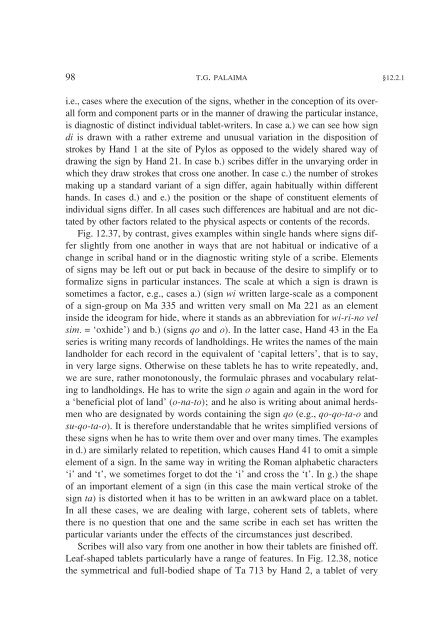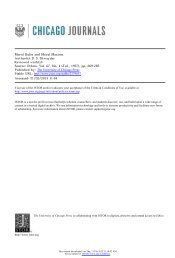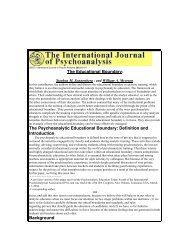A Companion to Linear B - The University of Texas at Austin
A Companion to Linear B - The University of Texas at Austin
A Companion to Linear B - The University of Texas at Austin
Create successful ePaper yourself
Turn your PDF publications into a flip-book with our unique Google optimized e-Paper software.
98 T.G. PALAIMA §12.2.1<br />
i.e., cases where the execution <strong>of</strong> the signs, whether in the conception <strong>of</strong> its overall<br />
form and component parts or in the manner <strong>of</strong> drawing the particular instance,<br />
is diagnostic <strong>of</strong> distinct individual tablet-writers. In case a.) we can see how sign<br />
di is drawn with a r<strong>at</strong>her extreme and unusual vari<strong>at</strong>ion in the disposition <strong>of</strong><br />
strokes by Hand 1 <strong>at</strong> the site <strong>of</strong> Pylos as opposed <strong>to</strong> the widely shared way <strong>of</strong><br />
drawing the sign by Hand 21. In case b.) scribes differ in the unvarying order in<br />
which they draw strokes th<strong>at</strong> cross one another. In case c.) the number <strong>of</strong> strokes<br />
making up a standard variant <strong>of</strong> a sign differ, again habitually within different<br />
hands. In cases d.) and e.) the position or the shape <strong>of</strong> constituent elements <strong>of</strong><br />
individual signs differ. In all cases such differences are habitual and are not dict<strong>at</strong>ed<br />
by other fac<strong>to</strong>rs rel<strong>at</strong>ed <strong>to</strong> the physical aspects or contents <strong>of</strong> the records.<br />
Fig. 12.37, by contrast, gives examples within single hands where signs differ<br />
slightly from one another in ways th<strong>at</strong> are not habitual or indic<strong>at</strong>ive <strong>of</strong> a<br />
change in scribal hand or in the diagnostic writing style <strong>of</strong> a scribe. Elements<br />
<strong>of</strong> signs may be left out or put back in because <strong>of</strong> the desire <strong>to</strong> simplify or <strong>to</strong><br />
formalize signs in particular instances. <strong>The</strong> scale <strong>at</strong> which a sign is drawn is<br />
sometimes a fac<strong>to</strong>r, e.g., cases a.) (sign wi written large-scale as a component<br />
<strong>of</strong> a sign-group on Ma 335 and written very small on Ma 221 as an element<br />
inside the ideogram for hide, where it stands as an abbrevi<strong>at</strong>ion for wi-ri-no vel<br />
sim. = ‘oxhide’) and b.) (signs qo and o). In the l<strong>at</strong>ter case, Hand 43 in the Ea<br />
series is writing many records <strong>of</strong> landholdings. He writes the names <strong>of</strong> the main<br />
landholder for each record in the equivalent <strong>of</strong> ‘capital letters’, th<strong>at</strong> is <strong>to</strong> say,<br />
in very large signs. Otherwise on these tablets he has <strong>to</strong> write repe<strong>at</strong>edly, and,<br />
we are sure, r<strong>at</strong>her mono<strong>to</strong>nously, the formulaic phrases and vocabulary rel<strong>at</strong>ing<br />
<strong>to</strong> landholdings. He has <strong>to</strong> write the sign o again and again in the word for<br />
a ‘beneficial plot <strong>of</strong> land’ (o-na-<strong>to</strong>); and he also is writing about animal herdsmen<br />
who are design<strong>at</strong>ed by words containing the sign qo (e.g., qo-qo-ta-o and<br />
su-qo-ta-o). It is therefore understandable th<strong>at</strong> he writes simplified versions <strong>of</strong><br />
these signs when he has <strong>to</strong> write them over and over many times. <strong>The</strong> examples<br />
in d.) are similarly rel<strong>at</strong>ed <strong>to</strong> repetition, which causes Hand 41 <strong>to</strong> omit a simple<br />
element <strong>of</strong> a sign. In the same way in writing the Roman alphabetic characters<br />
‘i’ and ‘t’, we sometimes forget <strong>to</strong> dot the ‘i’ and cross the ‘t’. In g.) the shape<br />
<strong>of</strong> an important element <strong>of</strong> a sign (in this case the main vertical stroke <strong>of</strong> the<br />
sign ta) is dis<strong>to</strong>rted when it has <strong>to</strong> be written in an awkward place on a tablet.<br />
In all these cases, we are dealing with large, coherent sets <strong>of</strong> tablets, where<br />
there is no question th<strong>at</strong> one and the same scribe in each set has written the<br />
particular variants under the effects <strong>of</strong> the circumstances just described.<br />
Scribes will also vary from one another in how their tablets are finished <strong>of</strong>f.<br />
Leaf-shaped tablets particularly have a range <strong>of</strong> fe<strong>at</strong>ures. In Fig. 12.38, notice<br />
the symmetrical and full-bodied shape <strong>of</strong> Ta 713 by Hand 2, a tablet <strong>of</strong> very

















